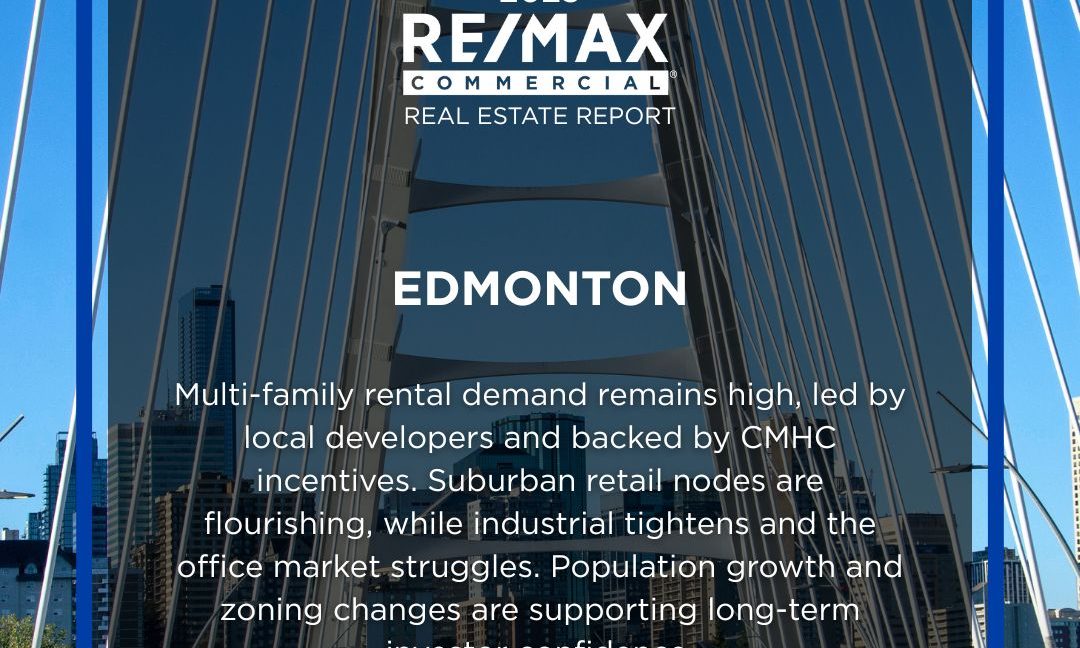Buoyed by ongoing population growth, multi-unit residential properties continue to be the strongest sector in the Edmonton commercial real estate market. In the absence of larger institutional players in city’s multi-family asset class, mid-size investors and private buyers are playing an increasingly important role in expansion. Private developers, in partnership with local government, are committed to increasing the city’s rental housing stock in areas close to the University of Alberta, McEwan and Concordia as demand continues to exceed supply. According to Statistics Canada’s Annual demographic estimates, census metropolitan areas and census agglomerations: Interactive dashboard, Edmonton’s population topped 1.6 million in July 2024. Just over 72,500 new residents were welcomed between July 2023 and July 2024, an increase of almost five per cent. Tight market conditions continue to impact rental rates, with prices edging higher. In its May 2025 rental report, Urbanation Inc. and Rentals.ca Network data noted that Edmonton was one of only two major markets to report an upswing in rental rates that brought the average value for rentals to just over $1,500 a month.
Favourable funding available through the Canada Mortgage and Housing Corporation (CMHC) has also contributed to the upswing in multi-family construction in recent years through the federal government’s Housing Accelerator Fund. Five-per-cent down payments, the ability to finance at favourable rates and longer amortization periods have incentivized many investors, although the inability to pull out equity and refinance projects has proven problematic to some.
A record number of purpose-built rentals were added to the market in 2024, relieving some of the pressure on the city’s vacancy rate.
A zoning by-law introduced in Edmonton in 2024, designed to improve affordability and accommodate population growth, has also encouraged the development of smaller investment properties with up to eight units on infill land in designated residential zones. The on-going effort to increase the city’s housing supply is supported by Edmonton’s Land Development team responsible for delivering residential land for sale in greenfield and infill neighbourhoods. Nine residential land development projects, in various stages from analysis to sales, are currently underway.
Retail redefines itself in the suburbs
Both institutional and private investors are behind robust demand for purpose-built retail centres in both new and established neighbourhoods. As the city continues to grow, there has been an uptick in demand, especially in newer suburban neighbourhoods, where there is a need for retail strip centres. Anchored by essential retail such as grocery or banks, the remaining tenant mix in today’s retail centres has shifted from the past, with service-based retail including healthcare centres such as chiropractors, dentists, and physio, dominating the landscape.
High-traffic areas continue to resonate with smaller retailers who are willing to pay a premium for greater exposure, but prime locations are hard to find. Given the shift to online shopping, foot traffic in local malls has subsided in recent years, with a notable turnover in tenants. Future development projects are complementing some existing properties, as is the case with Mill Woods Town Centre. The property has been renovated, with a grocery store scheduled to open in August, while construction will begin on two 22-storey towers this year. West Edmonton continues to be a popular destination for local and out-of-province shoppers, now offering with 800 stores and services, 100 places to eat, two hotels and 12 attractions.
Industrial tightens; office market still lags
Logistics, manufacturing, energy-related businesses and support services are driving demand for industrial product throughout Edmonton and the surrounding communities. Availability rates continued to track downward in the first quarter of 2025, according to Altus Group, down .80 basis points from the same period in 2024. However, an influx of new product is expected to place upward pressure on vacancy rates in the latter half of the year. Acheson remains Edmonton’s tightest industrial market, but with Parkland County rezoning parts of the industrial area to accommodate more light- and medium-use industrial, availability is expected to increase.
The office segment continues to be the weakest of all asset classes in Edmonton, with Altus Group placing availability rates at 19.7 per cent. The Stantec Tower and National Bank Centre (the former Manulife Place) continue to draw Class AA+ office tenants, while B- and C-class buildings are struggling to find prospective tenants. With some buildings half empty, landlords are offering lower lease rates and incentives, while others are offering month-to-month rentals. Unfortunately, despite these efforts, the occupancy is too low to make debt service coverage, despite an 80-per-cent return of remote and hybrid workers to the downtown core. Demand for office space is stronger in central Edmonton and is expected to strengthen further as urban sprawl continues.
Edmonton’s commercial real estate market continues to be underpinned by strong economic fundamentals across a diverse array of sectors, including energy and sustainability, technology and innovation, health and life sciences, and agriculture. With a promising outlook in store for 2025, driven by robust population growth and significant investments in real estate and infrastructure, the city is expected to continue attracting investors.
The post Edmonton Commercial Real Estate Overview (2025) appeared first on RE/MAX Canada.




